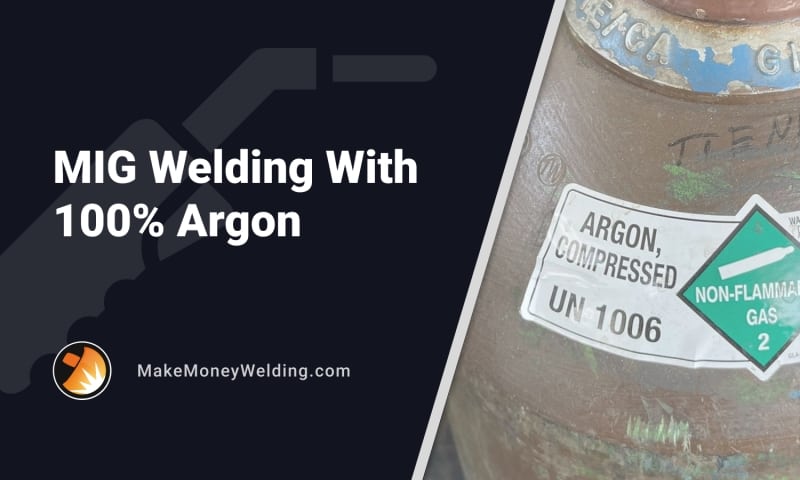MIG welding with 100% argon sounds like an unusual choice, but it has its place in welding. More known for its use in TIG welding, 100% argon is mainly used to weld non-ferrous metals like aluminum.
When MIG welding metals like steel, you should use a mixed shielding gas. Argon and carbon dioxide is the go-to option, but you can also use pure carbon dioxide.
In this article, I discuss everything you need to know about MIG welding with 100% argon. You’ll learn when to MIG weld with argon, factors to consider before welding, and what gas you should use to MIG weld steel.
MIG Welding with Pure Argon is Different
If you’re familiar with MIG welding, then the idea of welding with pure Argon may sound a little strange to you. Pure argon is usually associated with TIG welding, but it is possible to use it in MIG.
MIG welding with 100% argon is typically reserved for non-ferrous metals like aluminum.
You can use gases like argon, carbon dioxide, or helium to MIG weld non-ferrous metals. But, most welders prefer to use argon because it provides a cleaner weld and less spatter.
Keep in mind that argon has low thermal conductivity, so you’ll need to weld at a much slower speed – which can be costly.
I also don’t recommend MIG welding with any type of steel. Doing so can lead to poor weld quality, weak joints, and a shoddy appearance.
For MIG welding steel, you should use a mix of argon and CO2, or pure CO2, instead.
Keep this in mind when selecting a shielding gas for your next welding project.
Why Do MIG Welders Use 100% Argon?
As I mentioned earlier, MIG welders tend to use 100% argon when welding aluminum. But there are instances where they’ll use this gas for other metals.
Sometimes, welders have to use 100% argon because they can’t find a more suitable gas, and they need to finish the job fast. In other cases, pure argon might be the more affordable option.
Argon is a relatively affordable shielding gas. Add in its versatility and you’ll understand why it’s a popular choice for many welders who are on a tight budget.
How to MIG Weld With 100% Argon
The prep for MIG welding with pure argon is the same as how you’d prep to weld with any other shielding gas. You must make sure all tools and materials are clean and free of debris.
I recommend using a beveled edge because it penetrates better and produces a strong weld.
You should also avoid poor weather conditions, rain or strong winds, to preserve the argon.
Bevel Your Edges
What would happen if you butt-welded two pieces of ¼” plate together, without beveling the edges and cutting the piece in half?
A large chunk of the metal won’t join together.
That’s why you need to bevel the edges of your workpieces. It allows you to weld a larger surface area too, increasing penetration.
Beveling the edges also helps the weld resist fatigue and cracking. This allows you to weld more of the metal, as the beveled edges expose more surface area.
Keep the Heat High
Heat is extremely important when welding. You must make sure you select the correct voltage setting is. The heat or voltage applied is determined by the thickness of the metal you are welding.
Pure argon has lower thermal conductivity compared to other shielding gases. This means your puddle, or the welded area, will cool faster and narrower. The best way to combat this issue is to increase the voltage setting on your welder.
Use caution, especially on thinner metals, as too much heat will completely melt your material away. You’ll be left with a hole in your work that will be difficult to repair.
If possible, use a small practice piece of the same thickness to get the right settings.
Choose the Right Tip
Once you’ve got the right settings, it’s time to select the correct tip. Verify that the tip diameter matches the thickness of the wire. For example, you should only use a .025″ tip with a .025″ wire.
When it comes to selecting your gas nozzle, bigger is better. Remember that access to the weld itself may limit the size of the nozzle you can use. The larger the gas nozzle, the better the coverage you will receive.
Your weld must stay shielded to prevent the weld from becoming contaminated. Take great care in cleaning the nozzle of any spatter. MIG nozzle cleaners and anti-spatter solutions are also available. These solutions are often water-based and allow for easy cleanup.
The gas nozzle determines the amount of stick out or length of welding wire protruding from the tip. But, ⅛” to ¼” is the common amount.
Set the Flow Rate Properly
The last step before welding should be adjusting the flow of your shielding gas. The regulator on your tank has two gauges and a knob. One gauge shows the cylinder pressure of your tank. The other gauge displays your working pressure.
Many variables influence your chosen flow rate you. Some of these factors include nozzle size, material thickness, and natural occurrences. You should measure the flow rate in cubic feet per hour (CFH) and will generally be set between 15CFH and 35CFH. This is another scenario where practice material will come in handy.
Welding with less argon than required can make your weld appear porous and create a brittle weld.
Welding with too much argon can cause turbulence at the tip, but the finished result will appear the same. Both scenarios lead to an unpleasant welding experience, so make your adjustments carefully.
Advantages of an Argon/CO2 Blend When MIG Welding Mild Steel
Mild steel is one of the most common metals welders MIG weld. But the ideal shielding gas for this metal is a 75%/25% mixture of argon/CO2 is the choice, foremost welders.
Adding CO2 to the argon provides deeper penetration and assists with out-of-position welding. This combination also produces less spatter and provides a cleaner, stronger weld.
Better Puddle and Penetration
The mixture of argon and CO2 provides a steady arc and a smooth puddle. You will also notice deeper penetration, providing a more robust and nicer-looking weld. The arc is sturdier, less volatile, and easier to control.
It isn’t always possible to get comfortable or to find a way to support your hands and arms while working. But, with a mixed shielding gas, you can make the process easier.
No Undercutting and Less Spatter
Undercutting occurs when the thickness of the welded metal decreases. You will notice a slight dip or valley along the bead of your weld, and that area becomes weak and is prone to cracking.
Two factors that can cause an undercut in your work are an unstable arc and too much heat or voltage. Carbon dioxide has a high thermal conductivity.
So, you can use less voltage to weld and still increase penetration. Less heat from the welder reduces the risk of undercutting and will reduce spatter.
The addition of CO2 to the Argon helps to stabilize the arc and focus more heat on the area to be welded. A good comparison to use is painting. Think of welding with pure argon as painting with a 6” brush and welding with a 75/25% mix as painting with a 2” brush. It allows you to weld with more focus on one area.
Better Heat Control (Reduced Bending and Twisting)
Even the thickest metals will move when enough heat is applied to them; that’s why it is crucial to work in small areas and allow time for cooling. The welded area is generally the weakest part of your workpiece, even on a correctly done weld.
For this reason, carbon dioxide mixed with argon will make your weld stronger. Less voltage applied means less heat and less warping.
FAQs
Why does pure argon work well for TIG?
Pure argon works well for TIG welding because it protects the welded area from oxidation. It can also be used for most metals, including aluminum, mild steel, stainless steel, and Chromoly. Because of its ability to be used on most metals, it’s an easy choice for TIG welders to help minimize cost and save time.
Can I MIG weld steel with 100% argon?
The short answer is yes. Pure argon can be used to MIG weld steel, but it may not produce the best results and can be difficult even for an experienced welder. If you intend on using 100% argon to weld steel, it is recommended to dial in your settings and flow rate on a practice piece before getting started
What is pure argon used for in welding?
Pure argon is a popular choice in both MIG and TIG welding procedures. Because it is an inert gas and is non-flammable, it provides excellent protection from oxidation and is safe to use. It should be noted that argon can displace the air we breathe. If welding in a small, confined space, be sure to have a partner or a way to monitor the oxygen levels in the air.
Can you MIG weld stainless steel with 100% argon?
It’s not possible to weld stainless steel with pure argon. The preferred shielding gas for stainless is tri-mix. Tri mix includes 10% argon, 85-90% helium and 2-5% Co2. This mixture provides deep penetration and a stable arc, and it maintains the corrosion resistance found in stainless steel.
Wrapping It Up
That’s all you need to know about MIG welding with 100% argon.
To recap, only use 100% argon to MIG weld non-ferrous metals, and don’t try to use this gas on steel. 100% argon is an affordable option, but it’s not ideal for MIG welding most materials. If you go ahead and use it, it could lead to expensive mistakes.


